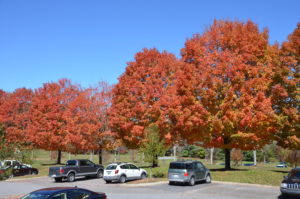Long term drought can be devastating on landscape and woodland trees. An environmentally stressed tree must expend additional energy to survive. Extremes of drought leads to decreases in trunk diameter and height growth, declining resistance to pests and diseases, less food production via photosynthesis, and in flower and fruit production. Symptoms of drought stress include wilted leaves, early leaf loss (defoliation), and leaf edge burn / brown leaves.
While newly planted trees and seedlings are in immediate jeopardy, droughts lasting 1-2 years generally do not kill large well-established trees. Long term dry periods lasting 5 or more years are a different matter, especially mature trees nearing the end of their lives. Stressed trees often die during the following growing season because trees are not able to re-leaf because of depleted energy reserves.
Drought denotes a period without precipitation during which the soil water content is reduced to such an extent that trees suffer. Water deficits in a tree occur when transpiration (the process by which leaves let off moisture and oxygen) exceeds the water amounts remaining to leaves.
Periods of droughts are common in some years in all regions of the U.S. Many landscape trees are stressed by prolonged periods of hot, dry weather. The landscaper’s goal should be to select tree species that utilize water more efficiently without the need for frequent watering (or irrigation). Many municipal water can and will prohibit landscape irrigation during long drought spells. Drought tolerant trees will be healthier and lower in maintenance.
Select trees that use water efficiently. Some examples:
- Native trees are better adapted to climate and pest conditions than non-native trees.
- Trees with small leaves (linden, elm, willow oak) are more easily cooled and more water-use efficiency than trees with larger leaves (sycamore, cottonwood, basswood, tuliptree).
- Upland species are generally more drought-resistant than bottomland species.
- Early successional species, those that colonize old fields and disturbed sites (pines, black locust, elms), use water more effectively than late successional species (sugar maple and beech).
- Trees with deep, upright crowns are more effective in water use than those with flat, wide-spreading crowns.
- Trees with multi-layered crowns having many branches and leaf layers (oak, ash, gum hickory) are more water efficient than those
trees with leaf canopies that concentrate leaves in single layers along the outer edge of the crown (beech, sourwood, redbud, magnolia).
- Drought-tolerant plants usually have thick bark and leaf waxes (cuticle), efficient stomatal control and extensive root systems.
Finally, some tree species respond to drought by shedding leaves prematurely or wilting. They include black cherry, basswood, beech, birch, buckeye, cottonwood, dogwood, sassafras, sugar maple, sycamore and yellow-poplar (tuliptree). These are not drought-resistant species.
*adapted from an article by Dr. Wayne Clatterbuck, Extension Forestry Specialist, University of Tennessee, Knoxville, TN




 Posted in
Posted in 
